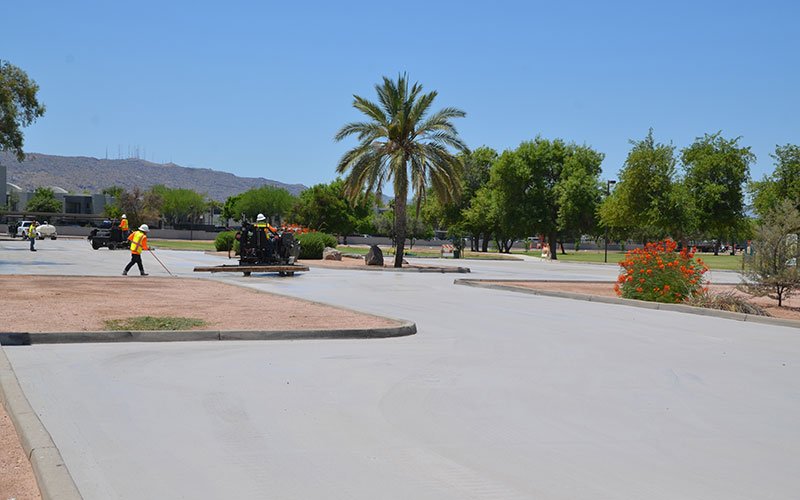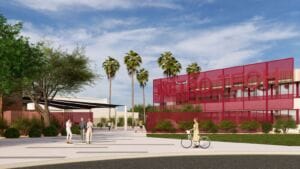An atypical coating was applied to a parking lot at Esteban Park in southeast Phoenix last month, topping gray, cracked asphalt with a smooth, off-white sealant.
The fresh look is more than a makeover: When the parking lot was coated June 12, it marked the start of Phoenix’s $3.3 million Cool Pavement Pilot Program, meant to mitigate sweltering summer night temperatures and make life at street level more bearable.
Asphalt, concrete and other man-made surfaces designed to be impervious to water are good at retaining heat captured on a summer day, according to urban climate experts from Arizona State University. Urban areas also have a great deal of thermal mass and emit a lot of waste heat from energy consumption. Some cities also lack the cooling moisture evapotranspiration from plants and trees in suburban or more natural habitats.
In cities like Phoenix and Los Angeles – dense with concrete and asphalt, and subjected to many hot, sunny days – ambient daytime heat can be stored in walls and pavement and carry over through the night.
This urban heat island effect is thought to contribute to higher electric bills and greenhouse gas emissions as residents rely more heavily on air-conditioning to battle the heat of desert city nights, according to Ariane Middel, a senior sustainability scientist at ASU.
“Even a degree change in Fahrenheit makes a difference,” Middel said. “You may not feel the one, two degrees necessarily, but your energy bill will reflect that.”
Lowering nighttime temperatures also can make living in Phoenix safer for those outdoors, such as the homeless population, and more bearable for lower-income residents who can’t afford air-conditioning.
Resurfacing asphalt with a brighter coating is proven to reflect sunlight and reduce the absorption of heat, according to ASU researchers. Initial tests by the Street Transportation Department on the Esteban Park lot showed a 10 to 15 degree difference between the surface temperatures of traditional asphalt and cool pavement.
The reduction isn’t just more comfortable for nearby residents, it can have broader benefits for sustainability efforts as the West grows hotter and drier. Researchers expect half a degree decrease in air temperature could save Phoenix as much as $15 million per year in avoided cooling costs and lower overall water consumption by 3% to 5%, said David Sailor, who directs the Urban Climate Research Center at ASU.
Phoenix officials chose the most effective of four sealants based on those tested in Los Angeles, which launched its pilot program in 2017, according to Rubben Lolly, the project lead for the pilot program in Phoenix. A blend of asphalt, water, soap, mineral fillers, polymers and recycled materials, cool pavement contains no harmful chemicals, city transportation officials said.
Reflective surfaces have been used for years on rooftops, Sailor and Middel said, which helps individual buildings alleviate heat absorption and mitigate cooling costs, but cool pavement could be more beneficial for pedestrians and others at street level.
The Cool Pavement Pilot Program will paint and research results at nine test locations, one in each municipal district and one selected by the mayor. The areas were chosen because they have good pavement but are diverse in terms of shade and traffic, which should allow researchers to consider variables when testing for effectiveness and durability.
The sealant will be laid on 16 more streets – totaling 624 square yards of pavement – by early October, Lolly said, adding that it costs about $5 per square yard to apply, which is four times that of regular asphalt sealant.
The sealant’s durability is another major consideration in the city’s cost-benefit analysis, Lolly said. But it will take at least a year to predict how the coat will hold up over time or whether effectiveness would be impacted by traffic – tire marks and spilled oil would darken the light color credited with the cooling effects.
For Lolly, the importance of the program isn’t to mitigate costs for the city, it’s to make life better for Phoenix residents.
“I don’t know if we were doing this to save the spending money rather than improve the quality of life for the citizens,” he said.
Sailor says mitigating the urban heat island effect also could reduce heat related illnesses and deaths. In 2019, there was a record number of 197 heat-related deaths in Phoenix, according to a Maricopa County Public Health report.
Officials in LA have adopted cool pavement as part of their sustainability efforts and aim to expand it 30% by 2045, according to a countywide sustainability plan.
Meanwhile, Lolly said Phoenix will continue testing at least a year before it decides on expansion.
Research is still in its infancy on the effectiveness of cool pavement in mitigating the overall heat island effect. Researchers at ASU continue to study whether the reflected sunlight increases UV exposure or absorbed body heat for cool pavement pedestrians in Los Angeles and Phoenix, but Middel is optimistic that there aren’t any proven harmful effects yet.
It will take several years before researchers can draw definitive conclusions about the large-scale impact of cool pavement for Phoenix, but researchers say it will take more than just asphalt coverage to combat the urban heat island effect. Increasing greenspaces by planting more trees and grass and increasing shade, which retain and evaporate moisture, Sailor said, offers another opportunity to alleviate the heat.
“It’s not one single strategy that will solve all our problems,” Middel said. “In the end, we have to use a whole suit or a whole variety of different strategies depending on the context, like depending on where you are and what you want to achieve.”
If nothing else, she says the light-colored pavements could be particularly beneficial for pedestrians, kids on playgrounds and dog-walkers, to save their pups’ paws.
Cool Pavement Pilot Program locations:
Mayor’s choice. Van Buren and Roosevelt streets between 12th and 16th streets.
1. Thunderbird Road and Acoma Drive between 47th and 43rd avenues.
2. Carefree Highway and Languid Lane from an “open space” to 27th Lane.
3. Shea Boulevard and Cholla Street between 40th and 44th streets.
4. Van Buren and Roosevelt streets between 31st and 27th avenues.
5. Campbell Avenue and Camelback Road between 55th and 51st avenues.
6. Las Palmaritas Drive and Dunlap Avenue between Central Avenue and Seventh Street.
7. Vineyard Road and Southern Avenue between 43rd and 39th avenues.
8. Esteban Park parking lot, 3345 E. Roeser Road.
Story by Bree Florence, Cronkite News




